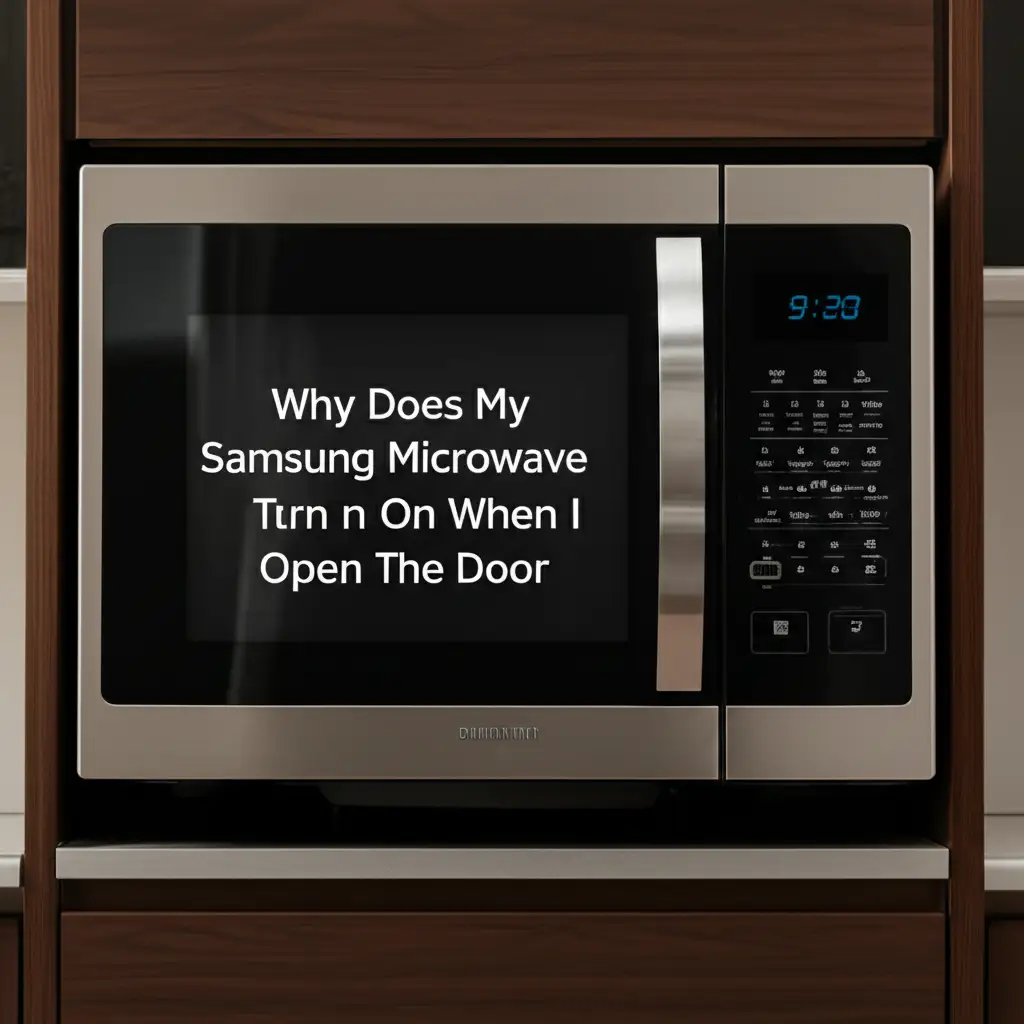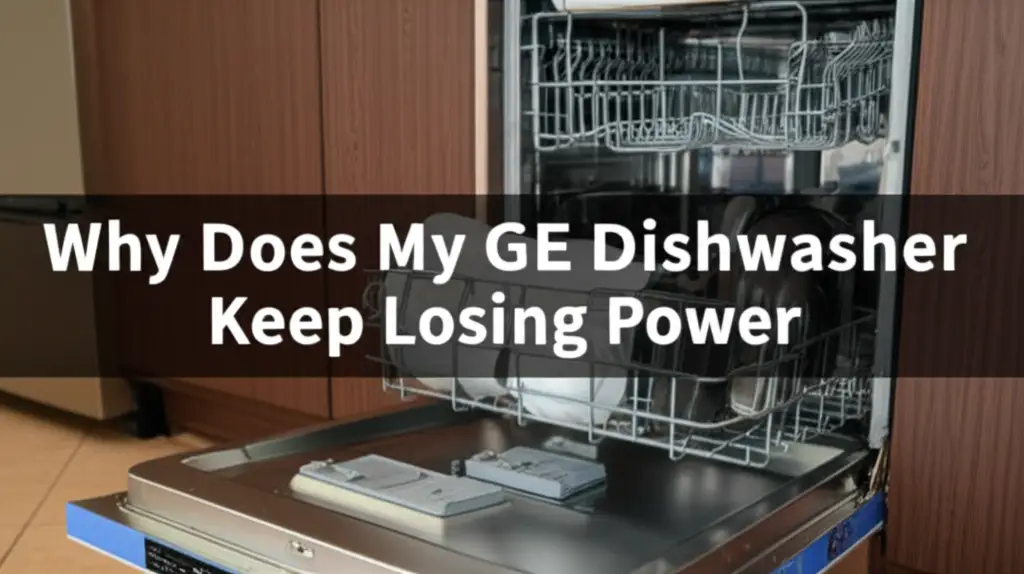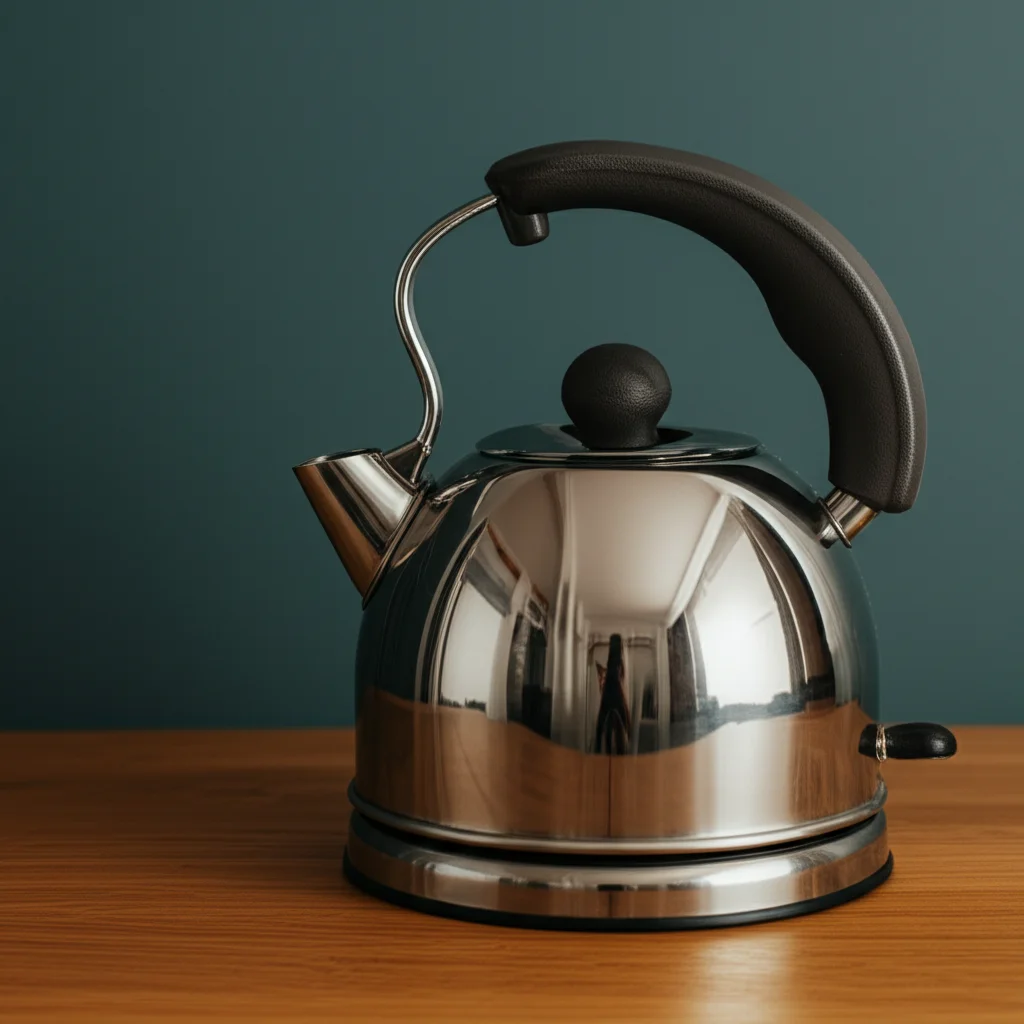· Todd Martin · Home Maintenance · 16 min read
Why Does My Samsung Microwave Turn On When I Open The Door

Why Your Samsung Microwave Turns On When You Open Its Door
It can be a truly unsettling moment when your Samsung microwave begins to act in unexpected ways. Imagine opening the microwave door to place or remove food, and instead of the appliance staying quiet, it powers on and even starts cooking. This is not just a strange glitch; it is a serious safety concern that demands immediate attention. Understanding why your Samsung microwave turns on when you open its door is the first step toward resolving this dangerous problem.
Microwaves are designed with specific safety features to prevent them from operating with an open door. When this system fails, it indicates a fault within the appliance’s critical safety mechanisms. I will guide you through the common causes of this issue. We will explore the role of the door interlock switches. We will also discuss safe diagnostic steps and explain when to seek professional help. Your safety is most important when dealing with microwave problems.
Takeaway
If your Samsung microwave turns on when you open the door, take these immediate actions:
- Unplug the microwave immediately: Do not use it again until repaired.
- Identify the faulty component: A defective door interlock switch is the most probable cause.
- Prioritize safety: Microwaves contain high-voltage components. Professional repair is often the safest option.
When your Samsung microwave turns on while the door is open, it typically means one or more internal door interlock switches are faulty or shorted. These switches are safety devices. They are designed to prevent the microwave from operating unless the door is securely closed. A fault causes the microwave to falsely believe the door is shut, leading to hazardous operation.
Unusual Behavior: Samsung Microwave Door Opens, It Powers On
Discovering your Samsung microwave activates when you open its door is highly alarming. This behavior is entirely abnormal and contradicts the fundamental safety design of microwave ovens. A microwave oven uses powerful electromagnetic waves to heat food. It is crucial for these waves to remain contained within the appliance’s cooking cavity. The door acts as a shield to keep radiation inside.
The microwave’s safety system is built around the door’s status. Normally, opening the door immediately cuts off power to the magnetron, which produces the microwaves. This ensures no radiation escapes while the door is ajar. When your Samsung microwave starts running with the door open, it signals a severe breakdown in this vital safety circuit. This problem can pose a radiation risk if not addressed quickly.
Many people might wonder if this is just a minor electrical issue. I want to stress that it is not. This problem points to a failure in components that protect users from harmful microwave energy. It is a clear sign that the appliance is unsafe to use. You must stop using the microwave at once. Unplug it from the wall outlet. This prevents any accidental operation and protects everyone in your home. Ignoring this issue can lead to potential health hazards.
The concern is particularly high with a Samsung microwave because these are complex appliances. They integrate advanced technology with basic safety features. Even a small defect in a key safety component can lead to major malfunctions. Understanding the gravity of this situation is the first step toward getting your appliance fixed properly and safely.
Understanding Microwave Safety Features: Interlock Switches Explained
Microwave ovens incorporate multiple safety features to ensure safe operation. At the heart of these features are the door interlock switches. These small, mechanical switches are critical. They detect whether the microwave door is properly closed and latched. Most microwaves have a system with at least three interlock switches. These switches work together in a sequence.
The first two switches, often called primary and secondary, are usually located near the door latch mechanism. Their main job is to complete the electrical circuit that allows the microwave to operate. When the door closes, these switches are depressed, closing their internal contacts. This permits electricity to flow to the high-voltage components, including the magnetron. If either of these switches fails to close, the microwave will not start.
The third switch is known as the monitor switch or safety interlock switch. This switch serves as a fail-safe. Its purpose is to intentionally short-circuit the power supply if the primary or secondary switches fail to open when the door opens. This action usually blows the main fuse, cutting off all power to the microwave. This design ensures that the magnetron cannot activate with the door open. This is a critical design for user safety.
When your Samsung microwave turns on with the door open, it means this carefully designed safety sequence is compromised. One or more of these switches are not functioning as they should. Instead of breaking the circuit when the door opens, a faulty switch might be completing it. This tricks the microwave into believing the door is closed. Such a malfunction turns a safety device into a source of danger. Proper diagnosis requires understanding each switch’s role.
The Core Problem: A Malfunctioning Door Interlock Switch
The primary reason your Samsung microwave turns on when you open the door points directly to a malfunctioning door interlock switch. These switches are small but vital safety devices. They ensure that power flows to the magnetron only when the microwave door is securely shut. When a switch fails, it can fail in several ways, leading to this dangerous behavior.
One common failure mode is that a switch gets stuck in the “closed” position. This means the internal contacts remain connected, even when the door is open. The microwave’s control board receives a signal that the door is shut, even though it is not. This false signal causes the microwave to power on, potentially activating the magnetron, which emits harmful microwave radiation. This is a serious flaw in the safety system.
Another possibility involves the monitor switch. This is the ultimate safety net. If the primary or secondary switches fail to open when the door is opened, the monitor switch is designed to short the electrical circuit. This action causes the main fuse to blow, immediately cutting off all power to the microwave. If the monitor switch itself fails, it might not perform its shorting function, leaving the door open and the microwave running. This situation is extremely rare but very dangerous.
Sometimes, the plastic levers or plungers that activate these switches can break or wear out. This physical damage prevents the switch from changing its state correctly. The broken lever might keep the switch permanently engaged. A wiring short inside the microwave can also bypass a switch, causing power to flow where it should not. Regardless of the exact mechanism, the outcome is the same: the microwave operates unsafely. Addressing this faulty switch is paramount for safety. Issues like a microwave blowing fuses when the door opens often point to related switch problems, demonstrating the critical role these components play in electrical safety. You can learn more about how door-related issues can affect microwave fuses by checking out this article: Why Does My Frigidaire Microwave Keep Blowing Fuses When I Open The Door.
Identifying the Fault: Signs of a Bad Samsung Microwave Door Switch
Pinpointing a faulty door interlock switch in your Samsung microwave requires careful observation. Besides the obvious problem of the microwave turning on when the door is open, there are other signs. Listening for specific sounds or noticing unusual operational quirks can help you identify a failing switch. This diagnosis process helps confirm the root cause of the hazardous behavior.
First, pay attention to the door itself. Does it latch securely? Sometimes, the door mechanism might feel loose or not click firmly into place. This can prevent the switches from engaging or disengaging properly. A loose door or misaligned latch can directly impact switch function. It might not be the switch itself, but the way the door interacts with it.
Next, listen for the characteristic click of the switches. When you slowly open and close the microwave door, you should hear a distinct click for each switch activating or deactivating. There are usually two or three clicks, indicating the primary, secondary, and monitor switches are working. If you hear fewer clicks, or no clicks at all, a switch might be stuck or broken. A lack of clicking sound often signals a mechanical failure within the switch.
Visual inspection can also offer clues. Look closely at the switches located near the door latch assembly. They are typically small, plastic components with a button or lever that moves when the door closes. Check for any visible damage like cracks, bends, or scorch marks. Any physical imperfection suggests a switch has failed. However, a switch can fail internally without showing external damage. For more in-depth troubleshooting of door switches, especially if you plan to do a DIY replacement, resources on how to replace a Whirlpool microwave door switch can offer similar general guidance, as the principles of microwave door switch replacement are often comparable across brands.
Ultimately, testing with a multimeter is the most reliable way to confirm a bad switch. This requires unplugging the microwave and accessing the switches. Each switch has a specific continuity state (open or closed) depending on whether it is pressed or unpressed. A faulty switch will show incorrect readings. However, always exercise extreme caution and consider professional help when dealing with microwave internal components.
Prioritizing Safety: Crucial Steps Before Any Troubleshooting
Safety must be your absolute top priority when dealing with a malfunctioning microwave oven. A microwave contains extremely high-voltage components. These parts can store a lethal electrical charge even after the appliance is unplugged. Ignoring safety precautions can lead to severe injury or even death. I want you to understand the risks involved before attempting any troubleshooting or repair.
First and foremost, unplug the microwave from the wall outlet immediately. This is the most critical step. Do not just turn it off; physically remove the plug. This action disconnects the appliance from its power source. It stops any current from flowing to the unit. Never assume the microwave is safe just because it is not running. Always unplug it completely.
Understand the danger of the high-voltage capacitor. This component stores a significant electrical charge. It can hold this charge for a long time even after the microwave is unplugged. Touching it directly or indirectly can deliver a dangerous shock. It is often encased in a protective cover. Never touch it without proper knowledge and discharge tools.
If you are not an experienced technician, do not open the microwave casing. Internal components, particularly the magnetron and transformer, operate at extremely high voltage. These components are not user-serviceable. Opening the casing without knowing how to safely discharge the capacitor is extremely risky. Even a small mistake can have fatal consequences.
I strongly recommend consulting a qualified appliance technician for this type of repair. They have the specialized tools, knowledge, and experience to safely diagnose and fix microwave issues. While some problems like an oven turning off when the door is opened might be less critical, a microwave turning on is a distinct, high-risk situation. You can see how other appliances handle door safety, such as why a Samsung oven turns off when you open its door. However, the internal high voltage of microwaves makes them far more dangerous for DIY repair. Do not take unnecessary risks with your safety or the safety of your family.
Diagnosing and Replacing Your Samsung Microwave Door Switch (DIY Cautions)
Attempting to diagnose and replace a Samsung microwave door switch is a task for individuals with significant electrical experience. Due to the high voltage components inside a microwave, this procedure carries substantial risks. I will outline the general steps, but again, I cannot stress enough the importance of safety and considering professional help.
Step 1: Unplug the Microwave and Access the Switches. First, unplug the microwave from the power outlet. Use a screwdriver to remove the outer casing. Most microwaves have screws on the back or sides. Once the casing is off, you will see the internal components. Identify the door latch mechanism and the switches connected to it. They are usually small, plastic boxes with wires attached.
Step 2: Discharge the High-Voltage Capacitor (Professional Step). This step is CRITICAL and should only be performed by a qualified technician. The high-voltage capacitor must be safely discharged. Technicians use a high-voltage probe or a ceramic resistor for this. Never attempt this without proper training and tools. If you are unsure, do not proceed.
Step 3: Test the Door Switches. You will need a multimeter for this. Disconnect the wires from each door switch, noting their positions. Set your multimeter to the continuity setting. Test each switch individually.
- Normally Open (NO) switches: Show no continuity when unpressed, and continuity when pressed.
- Normally Closed (NC) switches: Show continuity when unpressed, and no continuity when pressed.
- Monitor switch: Typically Normally Closed. If it fails to open when the door opens, it can cause problems. A faulty switch will not change its state correctly. It will show continuity when it should not, or vice versa.
Step 4: Remove the Faulty Switch. Once you identify the bad switch, carefully remove it. Switches are usually held in place by small tabs or screws. Take a picture or make a diagram of how the old switch is oriented and connected. This helps during reassembly.
Step 5: Install the New Switch. Purchase an exact replacement switch for your Samsung microwave model. Install the new switch in the same position and orientation as the old one. Reconnect the wires precisely as they were before. Ensure all connections are secure.
Step 6: Reassemble and Test (With Caution). Before reattaching the outer casing, gently close and open the microwave door. Listen for the distinct clicks of the new switch. Plug the microwave back in for a very brief test, but be ready to unplug it immediately if the problem persists. If the microwave still turns on when the door is open, unplug it again and seek professional assistance. Always ensure the casing is fully secured before extended use.
When Professional Help is Necessary for Your Microwave
While some minor appliance issues can be tackled by a confident DIYer, the problem of a Samsung microwave turning on when the door opens is not one of them. This is a critical safety hazard. Knowing when to call a professional technician is paramount for your safety and the longevity of your appliance. I strongly advise professional intervention for this specific issue.
One clear sign it is time to call a professional is if you lack experience with electrical repairs or internal appliance components. Microwaves contain high-voltage capacitors that can hold a dangerous electrical charge even when unplugged. Without the proper tools and knowledge to safely discharge this capacitor, you risk severe electrical shock. A certified technician has the training and equipment to perform this safely.
If your initial visual inspection or simple tests do not reveal an obvious problem, a professional can offer a definitive diagnosis. They possess specialized diagnostic tools that can pinpoint subtle electrical faults or intermittent switch failures. This helps avoid guesswork. They can accurately determine which of the door interlock switches is faulty, or if the problem lies with the control board or other components.
Furthermore, if you have replaced the door switches and the problem persists, it indicates a more complex underlying issue. This might involve the main control board, the high-voltage transformer, or a wiring short. These repairs are intricate and best left to experts. Attempting to fix complex electrical problems without proper expertise can worsen the damage. This can also lead to more expensive repairs or even render the appliance irreparable.
Finally, consider the warranty. If your Samsung microwave is still under warranty, attempting a DIY repair might void it. A professional repair from an authorized service center will maintain your warranty coverage. For peace of mind and guaranteed safety, calling a qualified appliance technician is the smartest decision. Your safety is worth the investment.
FAQ Section
Why is my microwave turning on when I open the door?
Your microwave turns on when you open the door because a safety interlock switch is faulty. These switches are supposed to cut power when the door opens. A defective switch can remain stuck in a “closed” position, tricking the microwave into thinking the door is shut. This allows the magnetron to activate unsafely.
Is it safe to use a Samsung microwave that turns on with the door open?
No, it is absolutely not safe. A microwave turning on with an open door indicates a critical failure in its safety mechanisms. This can lead to exposure to microwave radiation, which is harmful. Unplug the microwave immediately and do not use it until a qualified technician repairs it.
How many door switches does a Samsung microwave have?
Most Samsung microwaves, like other brands, have a system of at least three door interlock switches. These typically include a primary switch, a secondary switch, and a monitor switch. Each switch plays a specific role in ensuring the microwave only operates when the door is securely closed.
Can I replace the microwave door switch myself?
Replacing a microwave door switch is possible for experienced individuals, but it is highly risky. Microwaves contain a high-voltage capacitor that stores lethal electrical charges even when unplugged. Without proper training and tools to discharge it safely, you risk severe electric shock. Professional repair is strongly recommended.
What is the monitor switch in a microwave?
The monitor switch is a crucial safety component in a microwave. It acts as a fail-safe. If the primary or secondary door switches fail to open when the door opens, the monitor switch is designed to intentionally short-circuit the power supply, blowing the main fuse. This prevents the microwave from operating unsafely.
How much does it cost to fix a microwave door switch?
The cost to fix a microwave door switch can vary. It depends on the technician’s rates, your location, and the specific parts needed. Parts are generally inexpensive. However, the labor cost for a qualified professional to safely diagnose and replace the switch, accounting for the high-voltage risks, can range from $100 to $300 or more.
Conclusion
When your Samsung microwave turns on when you open the door, it signals a serious safety hazard. This unusual behavior indicates a failure within the appliance’s vital door interlock switch system. These switches are designed to ensure the microwave only operates when the door is securely closed. A malfunction means the microwave falsely believes the door is shut, leading to dangerous operation and potential radiation exposure.
I have explained how these safety switches work and why their failure causes this problem. We also covered the important steps for identifying a faulty switch. Remember, your safety is paramount. Always unplug the microwave immediately. Never attempt to open the casing or troubleshoot without understanding the extreme risks of high-voltage components. This issue demands careful handling.
While some basic diagnosis can be understood, professional repair is often the safest and most reliable solution. Certified technicians have the expertise, tools, and safety protocols to handle microwave repairs. Do not risk your well-being or further damage to your appliance. If your Samsung microwave exhibits this dangerous symptom, please seek professional help without delay. Prioritize safety; it is the most important thing.
- Samsung Microwave
- Microwave Repair
- Door Switch
- Appliance Troubleshooting
- Microwave Safety
- Electrical Faults





